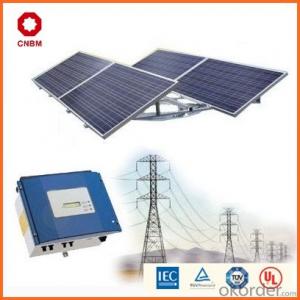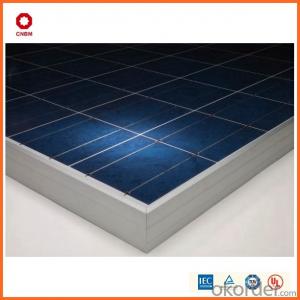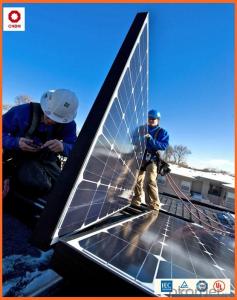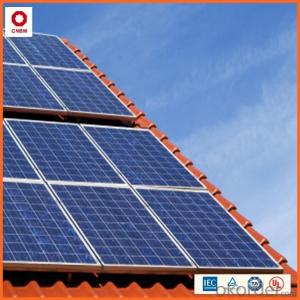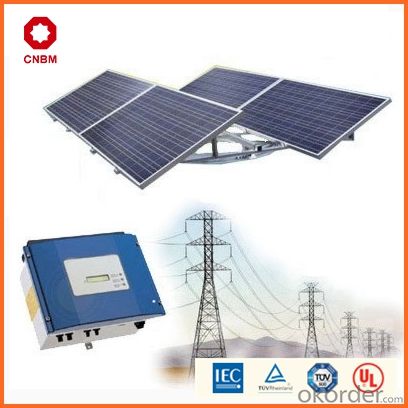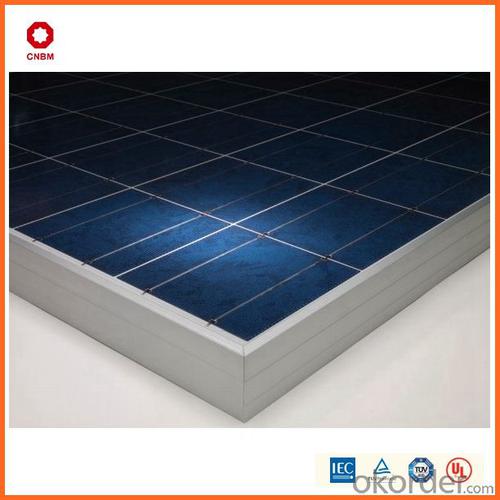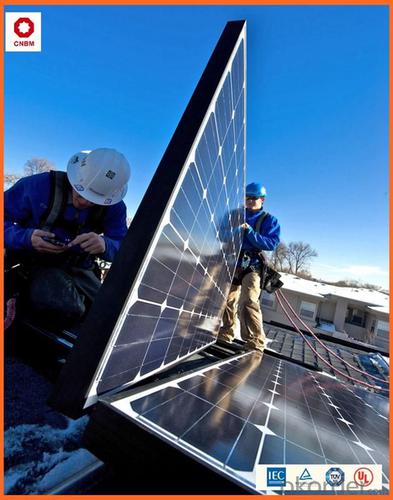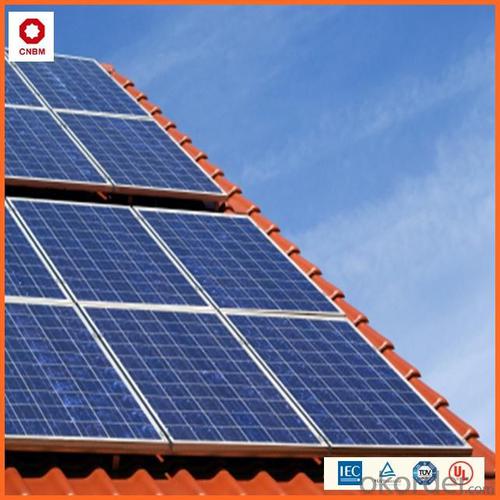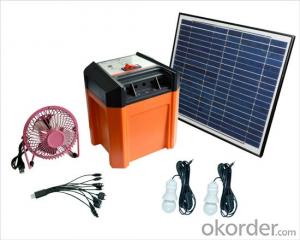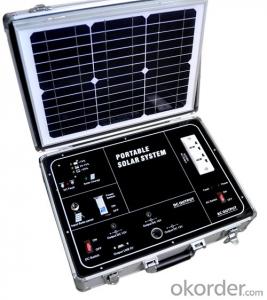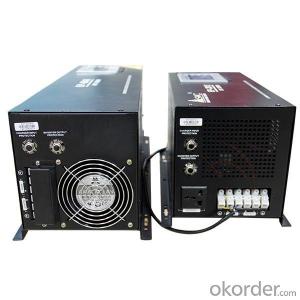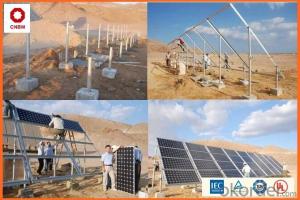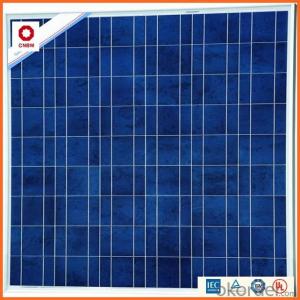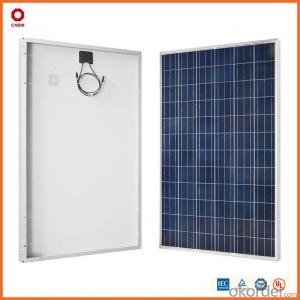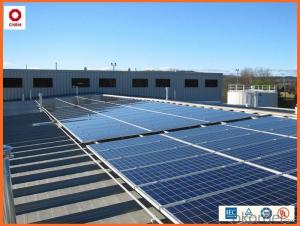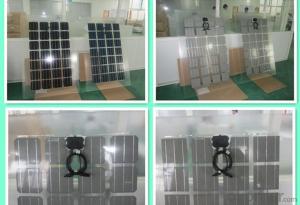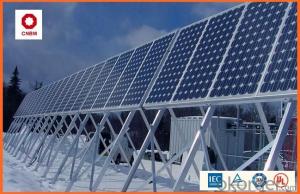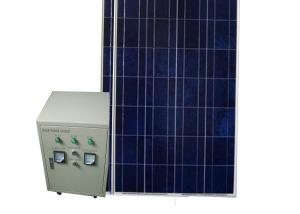Mpi Solar Energy Systems 65w Small Solar Panels in Stock China Manufacturer
- Loading Port:
- China main port
- Payment Terms:
- TT OR LC
- Min Order Qty:
- 1 watt
- Supply Capability:
- 10000000 watt/month
OKorder Service Pledge
OKorder Financial Service
You Might Also Like
Specification
Product Description:
Hot Sale !!! Quality and Safety of Small Poly Solar Panel 5w~150w
1. Rigorous quality control meets the highest international standards.
2. High-transmissivity low-iron tempered glass, strong aluminium frame.
3. Using UV-resistant silicon.
4. IS09001/14001/CE/TUV/UL
Warranties of Small Poly Solar Panel 35~85w
1. 10 years limited product warranty
2. 15 years at 90% of the minimal rated power output
3. 25 years at 80% of the minimal rated power output
Specification
Characteristics of Poly solar panels CNBM (245-320W) | |||||
Max Power Voltage Vmp(V) | 30.3 | 30.8 | 31.1 | 31.4 | 31.85 |
Max Power Current Imp(A) | 7.60 | 7.64 | 7.73 | 7.81 | 7.85 |
Open Circuit Voltage Voc(V) | 36.1 | 36.6 | 37 | 37.3 | 37.68 |
Short Circuit Current Isc(A) | 8.50 | 8.55 | 8.65 | 8.75 | 8.85 |
Max Power Pm(W) | 230W | 235W | 240W | 245W | 250W |
Temperature Coefficient of Cells Poly solar panels CNBM (245-320W) | |
NOCT | 45± 2 |
Temperature Coeffucients of Isc | 0.0492 |
Temperature Coeffucients of Voc | -0.3374 |
Temperature Coeffucients of Voc | -0.4677 |
Mechanical Data of Poly solar panels CNBM (245-320W) | |
Dimension | 1638 × 982 × 40 mm |
Weight | 19.5 kg |
No. of Cells and Connections | 60 (6 ×10) |
Tolerance | 0 ~ + 5 W |
Cell | Monocrystalline Cell 156 × 156 mm |
Packing | 624 Pcs/40ft(H) Container |
Limits of Poly solar panels CNBM (245-320W) | |
Operating Temperature | -40 to +85 |
Storage Temperature | -40 to +85 |
Max System Voltage | 1000VDC(IEC) / 600VDC(UL) |
Features of our products:
• High conversion efficiency mono/poly-crystalline amorphous silicon solar cells
• Modules incorporate high performance bypass diodes to minimize the power drop caused by shading
• High transmittance, low-iron tempered glass
• High performance EVA encapsulant to prevent destroying and water.
• AI frame: without screw, corner connection. 8 holes on the frame can be installed easily
• Good performance of preventing from atrocious weather such as wind and hails
• Certifications: CE IEC TUV VDE UL, Class I
• 10 years 90% power output warranty
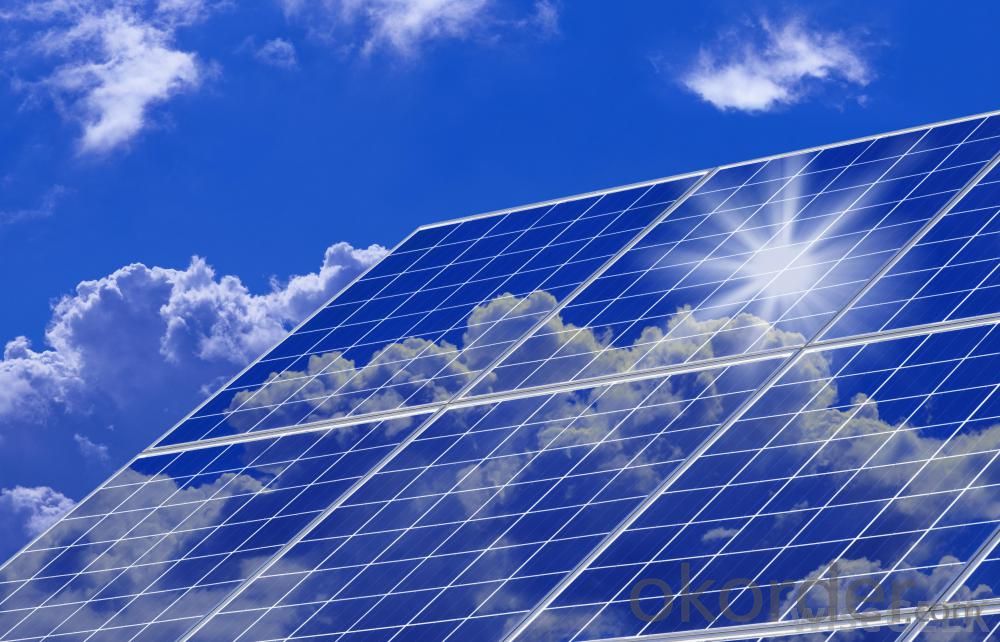
Shipping of Small Poly Solar Panel 35~85w
By Sea | Delivery from Shanghai or Ningbo seaport |
By Air | Departure from Shanghai Pudong Airport |
By Express | Post by DHL, EMS, UPS, TNT. |
Features of our products:
• High conversion efficiency mono/poly-crystalline amorphous silicon solar cells
• Modules incorporate high performance bypass diodes to minimize the power drop caused by shading
• High transmittance, low-iron tempered glass
• High performance EVA encapsulant to prevent destroying and water.
• AI frame: without screw, corner connection. 8 holes on the frame can be installed easily
• Good performance of preventing from atrocious weather such as wind and hails
• Certifications: CE IEC TUV VDE UL, Class I
• 10 years 90% power output warranty
As a professional Solar Panel manufacturer and Supplier in China, we have our customers come around the whole world and our specialization has got a worldwide recognition. Meanwhile, with our superior quality, competitive price, prompt and excellent service, As main role in trade section of CNBM Group, CNBM International Corporation supplies products including Monocrystalline Solar Panel, Polycrystalline Solar Panel ( multicrystalline silicon Solar Panel) have received and enjoyed famous reputation in many countries and regions in the world.
- Q: Can solar energy systems be used for powering outdoor appliances?
- Yes, solar energy systems can be used for powering outdoor appliances. Solar panels can be installed in outdoor areas to capture sunlight and convert it into electricity, which can then be used to power various appliances such as lights, fans, pumps, or even outdoor entertainment systems. This allows for a clean and sustainable energy solution for outdoor activities.
- Q: Can a solar energy system be installed on a farm?
- Yes, a solar energy system can be installed on a farm. In fact, farms are an ideal location for solar energy installations due to their vast open spaces and availability of sunlight. Solar panels can be mounted on rooftops of farm buildings or installed on the ground using mounting structures. The energy generated by the solar panels can be used to power various farm operations such as irrigation systems, lighting, heating, and cooling systems. Additionally, a solar energy system can help farmers reduce their reliance on traditional energy sources, lower their energy costs, and contribute to a more sustainable and environmentally friendly agricultural practice.
- Q: Do solar energy systems require planning permission?
- Yes, solar energy systems usually require planning permission. The regulations regarding planning permission for solar energy systems can vary depending on the country, state, or local jurisdiction. In many cases, installing solar panels on the roof or in the yard of a residential property may require obtaining planning permission from the local planning authority. This is done to ensure that the installation complies with building codes, aesthetics, and other relevant regulations. Similarly, commercial or large-scale solar energy projects may also require planning permission, as they can have significant impacts on the surrounding environment and infrastructure. It is essential to consult with the local planning authority or a professional solar installer to determine the specific requirements and processes for obtaining planning permission in a particular area.
- Q: What is the impact of dust storms on solar panels?
- Dust storms can have a negative impact on solar panels as they can reduce the panels' efficiency by blocking sunlight and reducing the amount of energy they can generate. The accumulation of dust on the panels can also lead to overheating, which can further decrease their performance and potentially damage the panels if not cleaned regularly.
- Q: Can solar energy systems be used in areas with high levels of dust?
- Yes, solar energy systems can be used in areas with high levels of dust. While dust can potentially reduce the efficiency of solar panels, it is still possible to generate electricity from sunlight. Regular cleaning and maintenance of the solar panels can help mitigate the impact of dust on their performance. Additionally, advancements in solar panel technology, such as anti-soiling coatings and self-cleaning mechanisms, have made it easier to maintain their efficiency in dusty environments. However, it is important to note that the effectiveness of solar energy systems in dusty areas may vary depending on the severity and type of dust present.
- Q: Can solar energy systems be used in powering restaurants or food chains?
- Solar energy systems are a viable option for providing power to restaurants and food chains. They are an eco-friendly and sustainable source of energy that can effectively reduce operational expenses and minimize the environmental impact of these establishments. Solar panels can be installed on rooftops or in open areas to capture sunlight and convert it into electricity, which can then be utilized for various functions within restaurants, including lighting, refrigeration, cooking equipment, and air conditioning. By adopting solar power, restaurants and food chains not only save on their energy bills but also showcase their dedication to sustainability and environmentally-conscious practices. Moreover, certain governments offer incentives and tax advantages to businesses that opt for solar energy systems, making it an even more appealing choice. All in all, solar energy systems are a practical and eco-friendly solution for powering restaurants and food chains.
- Q: Are there any risks of electrical fires with solar energy systems?
- Yes, there are potential risks of electrical fires associated with solar energy systems. While solar energy systems are generally considered safe, there are a few factors that can increase the risk of electrical fires. One of the main risks is improper installation or maintenance of the system. If the wiring is not done correctly or if there are issues with the electrical connections, it can lead to overheating and potential fire hazards. Additionally, if the solar panels are not properly grounded or if there are faults in the system, it can also increase the risk of electrical fires. It is crucial to hire qualified professionals for installation and regular maintenance of solar energy systems to minimize these risks. Fire safety precautions such as using appropriate wiring, installing proper fire detection and suppression systems, and ensuring adequate ventilation around the solar panels can further reduce the risk of electrical fires. Overall, while solar energy systems are generally safe, it is important to be aware of these risks and take necessary precautions to mitigate them.
- Q: Can solar energy systems be installed on industrial facilities?
- Yes, solar energy systems can be installed on industrial facilities. In fact, many industrial facilities have already adopted solar energy as a viable and sustainable source of power. These systems can significantly reduce energy costs, decrease reliance on fossil fuels, and contribute to a greener and more sustainable future for industrial operations.
- Q: What is the efficiency of solar energy systems?
- Usable energy from solar energy systems relies on the conversion of sunlight, which is commonly measured as a percentage of the total sunlight that strikes the solar panels' surface and turns into electricity. Various factors contribute to the efficiency of solar energy systems, including the type of solar panel technology, panel quality, panel location and orientation, and environmental conditions. Presently, solar panels available in the market typically have an efficiency range of 15% to 20%. However, more advanced technologies like monocrystalline and polycrystalline panels can achieve higher efficiencies, reaching up to 25%. It is important to note that advancements in technology and research continually enhance the efficiency of solar panels. Scientists and engineers work tirelessly to develop more efficient solar cells and panel designs to maximize energy harnessing from the sun. Moreover, evaluating the overall performance of solar energy systems requires considering factors beyond efficiency. Installation cost, maintenance requirements, and the availability of sunlight in a specific area are also significant considerations to determine the effectiveness and suitability of solar energy systems.
- Q: Can solar energy systems be used for powering off-grid mining operations?
- Yes, solar energy systems can be used for powering off-grid mining operations. Solar power can provide a reliable and sustainable source of electricity to mining operations in remote areas where grid connections are either unavailable or unreliable. By harnessing the power of the sun, solar energy systems can generate electricity to meet the energy demands of mining operations, reducing their dependence on expensive and polluting fossil fuels. Additionally, solar energy systems can be customized to suit the specific energy requirements of mining operations, making them a viable and environmentally-friendly alternative for off-grid power supply.
Send your message to us
Mpi Solar Energy Systems 65w Small Solar Panels in Stock China Manufacturer
- Loading Port:
- China main port
- Payment Terms:
- TT OR LC
- Min Order Qty:
- 1 watt
- Supply Capability:
- 10000000 watt/month
OKorder Service Pledge
OKorder Financial Service
Similar products
Hot products
Hot Searches
Related keywords
